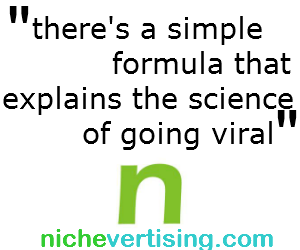 One of the things you will see me repeat over and over again in this blog is that getting an advertising campaign to go viral is both an art and a science, and therefore requires both left brain and right brain thinking.
One of the things you will see me repeat over and over again in this blog is that getting an advertising campaign to go viral is both an art and a science, and therefore requires both left brain and right brain thinking.
We all know you can’t condense the “art” of making something go viral into a nice neat formula. However, there is a simple formula that explains the “science” of going viral.
The basic idea is that for an advertising campaign to go viral, for every person that views it, it must be shared so that it is viewed by more than 2 other people.
This basic concept is very well known by bootstrapping entrepreneurs launching businesses based on web software. In that industry, this concept is taken a step further and tracks going viral down to how many actual prospective customers sign-up as new customers (measured as the conversion rate).
This more detailed view of going viral is the one I like to focus on.
Real World Example of Using a Formula to Go Viral
I want to break down this “trying to make a dollar out of 15 cents” idea in the context of email marketing. Let’s just say you send out an email campaign with the goal of getting a list of your prospects to attend an event you’re hosting.
Let’s also say your email list consist of 100 people. Because you are a marketing guru, you come up with a campaign that encourages people to share your email with friends.
The campaign is that if a person invites two friends to the event, their ticket is free….
Once your beautifully designed and written email campaign is delivered, you then can start measuring its effectiveness at going viral.
Using the Viral Coefficient
This is done using a formula to calculate the campaign’s viral coefficient. The viral coefficient is a scientific representation of the growth the campaign is delivering for you. A viral coefficient above 1 means you are getting exponential growth.
The way to calculate this number in this email marketing scenario is straight forward if you don’t mind doing a little math. You could also use this viral coefficient calculator we created here.
Let’s just say this campaign creates a nice 10% conversion rate. The first step is to multiply 100 (the number of prospects you are emailing) times 10% (the percent that actually sign-up for the event), which equals 10. So your initial email campaign generates 10 people for your event.
Now since your campaign encourages everyone to invite two people so they can get in free, let’s say every one of these 10 people invites 2 of their friends so they can take advantage of your offer.
That means you have another 20 invites emailed out. Because of the friend to friend email relationship of the invite, your conversion now jumps up to a whopping 50%. So you multiply 20 times 50%, and get 10 new people for your event and you now have 20 total guest attending.
This next cohort of 10 people get the same opportunity to get in free if they invite two guest. They also get a 50% conversion rate and generate another 10 people for your event putting you to 30 total guest attending.
This calculates the first two iterations through the viral loop and the idea here is that every new event guest keeps inviting 2 other guest so they can get in free. This creates a consistent loop of email, sign-up, invite 2 friends.
The way you calculate your viral coefficient is just by multiplying the number of invites each new customer sends (2) times the conversion rate from sharing (50%).
Even with a huge 50% conversion rate from friends who share, you only get a viral coefficient of 1 if they send only 2 invites. This is enough for linear growth (which is still good), but not for viral growth (which is awesome).
Viral = Viral Coefficient > 1
Your coefficient must be greater than 1 for viral growth. So in this case if you could get every sign-up to send at least 3 invites instead of 2 and keep your conversion rate close to 50% you would get a viral coefficient of around 1.5 and you would have captured the holy grail of going viral.
So as you see, creating an advertising campaign that encourages sharing is a fantastic way to grow your business.
In addition, being able to measure how viral each one of your campaigns goes is a great way to learn what works and what doesn’t. Then by making continuous improvements, you will keep getting closer and closer to creating the all so coveted viral loop.

There are 15 comments. Add yours.